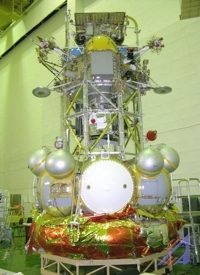
As NASA prepares for the November 25 launch of America’s next mission to Mars, the recent experience of the joint Russian-Chinese Phobos-Grunt probe (pictured at left) is a poignant reminder of how many missions to the Red Planet have ended in failure.
With the conclusion of NASA’s space shuttle program on July 21 of this year, renewed attention is being given to the Russian Federal Space Agency (often called Roscosmos). The United States is now dependent on the Russian Soyuz for transporting NASA’s astronauts to and from the International Space Station. Time magazine has even declared the current period to be “America’s Soyuz Era” — a stunning turn of fate for a nation that once triumphed over the Soviet Union in the race to the moon. But the significance of the U.S. manned space program relying on the Russian space agency is highlighted when one considers the relative success of the two nations in the realm of unmanned space exploration.
Russia’s Phobos-Grunt probe was launched on November 8, but has thus far failed to leave Earth orbit. With the window of opportunity for the probe to successfully reach Mars quickly coming to a close, a last ditch effort is underway to get the mission on its ten-month journey to Phobos, one of moons of Mars. According to a story for The Telegraph, Roscosmos director Vladimir Popovkin denied that Phobos-Grunt is “lost” at this point:
“The probe is going to be in orbit until January, but in the first days of December the window will close” to re-programme it, he told Russian news agencies at Russia’s Baikonur cosmodrome in Kazakhstan.
“There is a chance, but we have still not obtained the telemetric information to understand what happened” after the launch, he added, quoted by the Interfax news agency.
If the Phobos-Grunt ultimately fails to accomplish its mission, it would be a familiar conclusion to Russian and Soviet efforts to reach Mars. The first five attempts to send a probe to Mars were all launched by the Soviet Union between October 1960 and January 1963. All five attempts ended in failure. America’s first Mars mission — Mariner 3 in 1964 — ended in failure, but Mariner 4 successfully reached its goal in July 1965. In fact, from 1960 to the present, only roughly one-fourth of all Soviet/Russian missions to Mars have achieved what could be called even partial success; the rest ended in failure.
Phobos-Grunt was intended to land on the surface of Phobos and successfully collect a sample of material gathered from that moon and return it to Earth. In addition, the probe was supposed to take China’s Yinghuo-1 orbiter to Mars, as well as the Planetary Society’s Living Interplanetary Flight Experiment (Phobos LIFE). The Chinese orbiter was intended to be China’s first spacecraft to reach Mars, and its intended mission was to study both the surface and atmosphere of Mars, as well as studying the ionosphere and magnetic field. The Planetary Society’s tiny capsule was intended to study the ability of organisms to survive in deep space; select forms of eukaryote, bacteria and archaea were incorporated into Phobos LIFE to evaluate the effects of deep space conditions on such primitive forms of life, in an attempt to assess the likelihood of life spreading between planets in the solar system.
With the Phobos-Grunt mission giving every appearance of being on the verge of officially becoming another failed Russian mission, NASA is preparing to launch its next, and largest, Mars rover. If all goes according to plan, Curiosity will launch on November 25 and arrive on Mars next August. At fifteen times the weight of any previous rover, Curiosity poses new challenges — including a more complicated landing sequence than has been utilized for previous rover missions. Still, if Curiosity succeeds in traversing the distance between the two worlds and safely reaches its intended landing area in Gale Crater, it will arrive with a planned mission of two years. (It should be noted that Spirit and Opportunity both arrived on the Martian surface with a planned mission of a mere 90 days; a combination of superb engineering and good fortune extended the mission of both rovers long beyond their expected life.)
Probes such as Phobos-Grunt and rovers such as Curiosity can do a great deal to explore the surface of Mars remotely; it remains to be seen whether either a private or governmental program will successfully bring human beings to the Red Planet within the next generation. The debate about the existence and mission of NASA will no doubt continue to be debated — especially in light of the current economic crisis centering on the deficits and debt generated by the spending agenda of federal government. However, if America is going to have a space program, relying on the Russians has little to commend it; and an incident that appears to be the latest Russian failure on the path to Mars causes America’s pattern of relative success in recent years to shine as a testament of American engineering.



